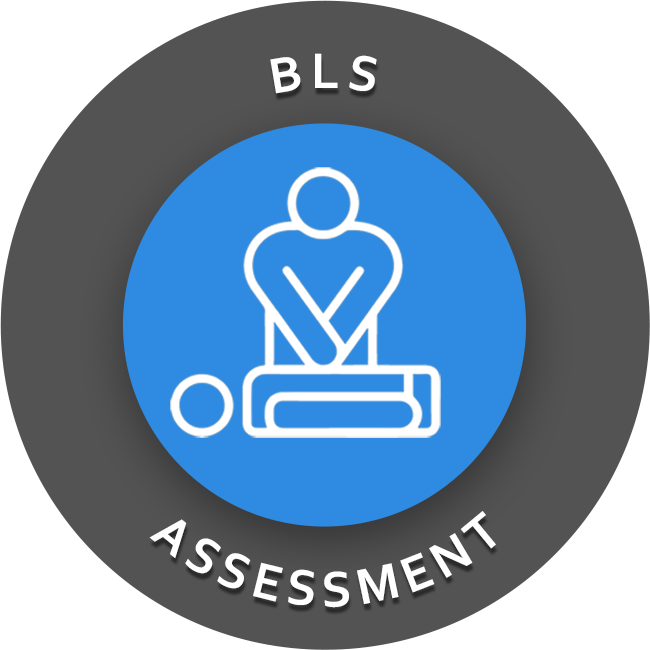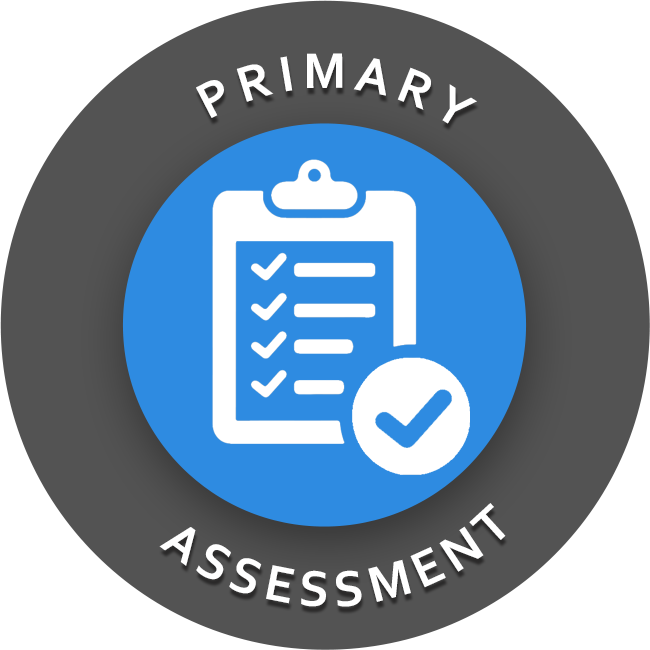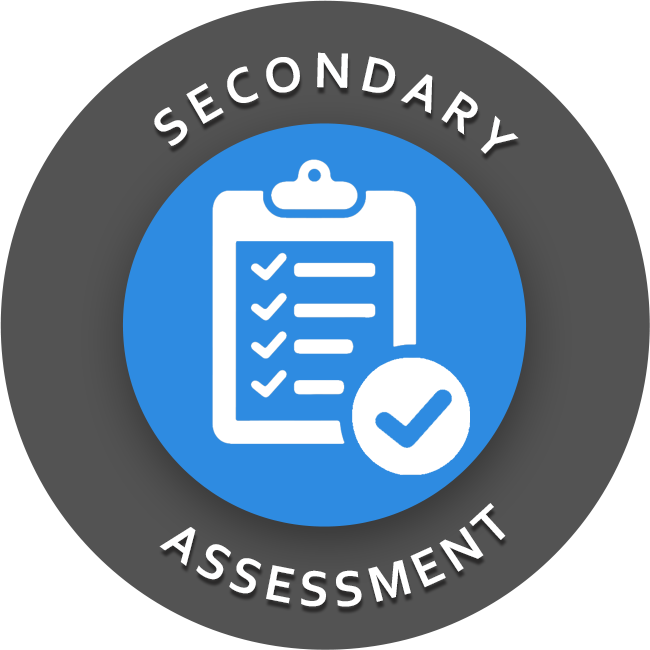
BLS Assessment
Foundational to every ACLS Algorithm is the BLS Assessment. The BLS Assessment is the first step that you will take when treating any emergency situation, and there are 4 main assessment steps to remember.
This is an outline of the 4 steps in the BLS Assessment :
(1) Check responsiveness by tapping and shouting, “Are you all right?” Scan the patient for absent or abnormal breathing (scan 5-10 seconds).
(2) Activate the emergency response system and obtain a AED. If there is more than one rescuer, have the second person activate emergency response and get the AED/Defibrillator.
(3) Circulation: Check for a carotid pulse. This pulse check should not take more than 5-10 seconds. If no pulse is palpable begin CPR.
(4) Defibrillation: If there is no pulse, check for a shockable rhythm with the AED or defibrillator as soon as it arrives. Follow the instructions provided by the AED or begin ACLS Protocol.
For a more in-depth review of BLS refer to the American Heart Association’s BLS Provider Manual.
Remember to assess first then perform appropriate actions, and after each action…reassess.

Primary Assessment for ACLS
The Primary Assessment uses the ABCDE model to systematize the assessment process. The ABCDE’s of the Primary Assessment are:
(A) Airway: Maintain airway and use advanced airway if needed. Ensure confirmation of placement of an advanced airway and secure the advanced airway device.
(B) Breathing: Give bag-mask ventilation, provide supplemental oxygen, and avoid excessive ventilation. Also, adequacy of ventilation and oxygenation should be monitored during this step.
(C) Circulation: Obtain IV access, attach ECG leads, identify and monitor arrhythmias, giving fluids if needed, and use defibrillation if appropriate.
(D) Disability: Perform a general neurological assessment which should include assessment of responsiveness, level of consciousness, and pupil reflex. AVPU acronym may help. (Alert, Voice, Painful, Unresponsive)
(E)Exposure: Ensure that clothing is removed so that a complete visual assessment can be performed. This visual assessment should include looking for signs of trauma, bleeding, burns, or medical alert bracelets.
The Primary Assessment is included in every ACLS algorithm and like the BLS Assessment, it helps to systematize the resuscitation process and improve patient outcomes.

Secondary Assessment for ACLS
The secondary assessment includes a search for underlying causes for the emergency and if possible a focused medical history. This search for for underlying causes, also known as differential diagnosis, requires a review of all of the H’s and T’s of ACLS. Visit H’s and T’s page for a full review.
Performing the focused medical history can be simplified using the acronym SAMPLE. (S)Signs and symptoms; (A)Allergies; (M)Medications; (P)Past Illnesses; (L)Last Oral Intake; (E)Events Leading Up To Present Illness.
Use the links to the left for further details of ACLS Protocol and specific interventions in each ACLS algorithm.
The objective of the review of these ACLS Algorithms is to help prepare you for the ACLS written test and the ACLS Megacode. After reviewing, you can test your skills and knowledge by accessing the ACLS Megacode Simulator and ACLS practice exams.
kngrmd@gmail.com says
So now if I’m doing ACLS , should i remember CAB sequence or only ABCD sequence?
kindly reply thanks
Jeff with admin. says
ABCD (airway, breathing, circulation, defibrillation) is for the ACLS Survey as showing the the page above. This is different than the Sequence of CPR which is CAB. Chest compressions, Open the airway, Provide rescue breaths. Kind regards, Jeff
kngrmd@gmail.com says
isnt it illogical that BLS changed it to CAB while ACLS still maintains it with ABCD? Just wondering if there is any logic or it is actually illogical etc?
thanks in advance
Jeff with admin. says
CPR would have already been initiated so you would have already gone through CAB. So the sequence would be start BLS (1,2,3,4) then CPR (CAB) the AC LS survey (A,B,C,D)
pilskyto says
Just passed my ACLS today!!! thanks !!!
etirado says
After taking this course online can I get certified online or do I have to go somewhere to get certified.
Jeff with admin. says
Reply:
This course is strictly for training purposes. It will help prepare you for AHA ACLS certification. After preparing you will need to find a local AHA ACLS provider to take the written exam and the skills station. You can find a local provider by using the AHA Class locatorAHA class locator:
Also, here is a page that explains about how to get AHA ACLS certified:
https://acls-algorithms.com/acls-certification/
Kind regards,
Jeff
Hien says
I still in doubt why we perform CPR with two rescuers for adult the ratio is still 30:2, but for child and infant the ratio is 15:2. Appreciate if you can explaint why it is different ratio compression between adult and Child or Infant with two rescuers?
Thank you very much
Jeff with admin. says
Adults, children, and infants have different needs when it comes to CPR. Infants and children have a greater ventilatory demand. Their ventilatory needs are normally higher than that of an adult. For 2 rescuer CPR, providing a ratio of 15:2 would give the child a greater number of breaths per minute and thus help ensure that their respiratory need is met.
Kind regards,
Jeff
johannarocco says
I like the font, the design of the pages, pleasurable to the eye and the mind.
I’m understanding the material. I’m getting it.
Thank you for this informative and thoughtful site.
Johanna
Jeff with admin. says
I’m so glad that you like it and I’m glad that it is helping you. Kind regards, Jeff
CordeAmare says
My understanding on the 2010 changes is Circulation comes before Airway & Breathing on BLS Survey- an emphasis on Chest Compression. Does that pattern apply as well to the ACLS model? Or does the ABCD model stays intact? Thanks
Jeff with admin. says
For BLS the sequence is CAB. For ACLS the ABCD model remains intact. In 2010, when the guidelines came out, there was some confusion among students about this, and this is why I created this page emphasizing the difference.
Kind regards,
Jeff
Jeanne O'Connor says
Found your site 2 years ago…… Would never take my certification without this site. Will certify next week, not anxious at all.
Thank you!
tetratetra says
You Know, It’s always agood idea to start out with the basics. What is a cycle? Do 5 cycles add up to 2 minutes? If not, which is most important?
Jeff with admin. says
One cycle of CPR is 30 chest compressions and two respirations. Five cycles of CPR equals approximately two minutes.
Kind regards,
Jeff
jamx575 says
Just joined. So far I am impressed with the format. Very easy to review and follow.
SMJ15 says
Great site. Passed ACLS site very helpful
Richard says
Does the BLS assessment always prelude the primary assessment or are there scenarios where you would move straight to the primary assessment?
Jeff with admin. says
Within the health care setting, there will be a lot taking place simultaneously.
There are aspects of the BLS assessment and the primary assessment that will overlap.
Just remember: There are 2 things that significantly improve outcomes. 1.) High quality chest compressions. 2.) Early defibrillation.
Kind regards,
Jeff
Ofelia Sanclemente says
Well designed on line coarse, i was very confident when taken my test, thanks again Jeff.
Rhaine says
Hi Jeff,
This may be a simple question, but can u please provide to me the placements of the leads? 4 leads (red, black, yellow, green) I don’t have the book and I’ve already learned this I just need to refresh my knowledge.
Jeff with admin. says
Here is an image that shows a good example of 4 lead placement. Take a look at the top two small images. Kind regards, Jeff
Beatriz Harter says
Thank you for all your help! This site is awesome. It is very interactive and exciting!
Bea
juneandtraci says
I am still somewhat confused as to when to use the CAB and the BLS survey. Would the bls survey be used when initially evaluating a pt and then ( if needed) the CAB used of initial life support until ATLS can be started? ( I do not yet have my ATLS manual , it is in the mail) Thanks , Love your site , very helpful .
Jeff with admin. says
Yes, this is correct. The BLS Survey and “CAB” is used upon initial evaluation. Once a crash cart/defibrillator is available you would move on to more advanced ACLS protocols.
Kind regards,
Jeff
Jenesis says
Sir good day, I would like to ask if patient is witnessed arrest, are we supposed to complete the 5 cycle of chest compression before giving a shock or we can interrupt chest compression to give a shock as soon as AED is available? Thank you and God bless.
Jeff with admin. says
If the arrest is witnessed, you can interrupt chest compressions attach the AED and shock the patient.
If the arrest is not witness, you should complete the entire 5 cycles (2 minutes) of CPR.
Kind regards,
Jeff